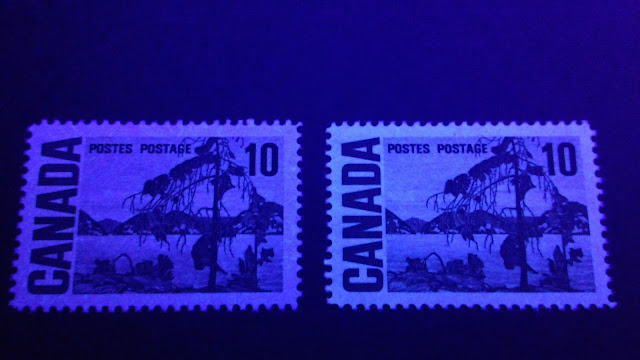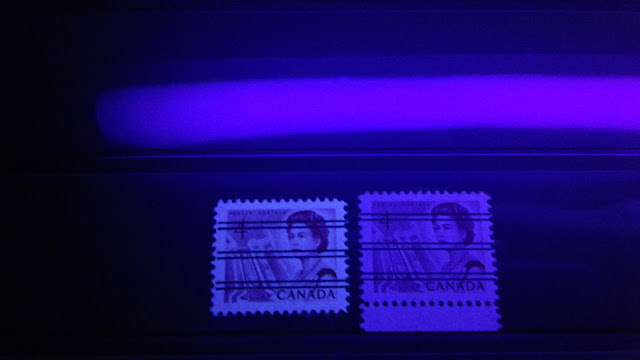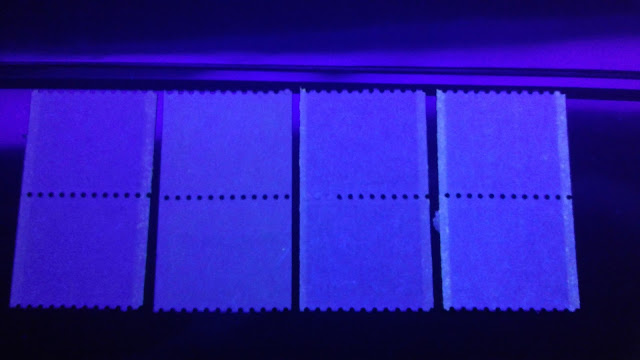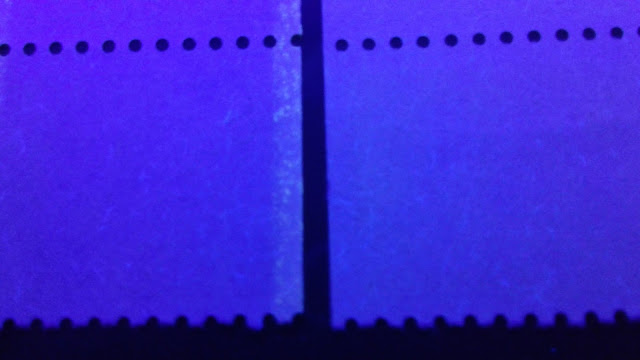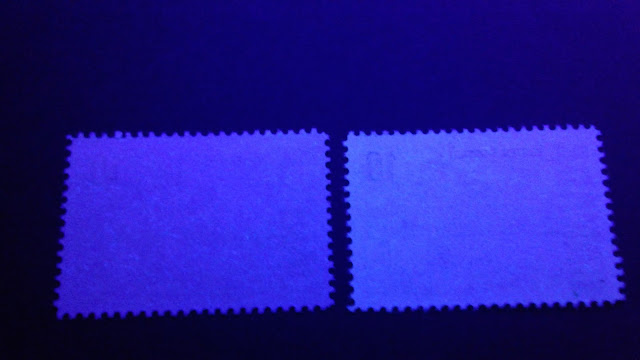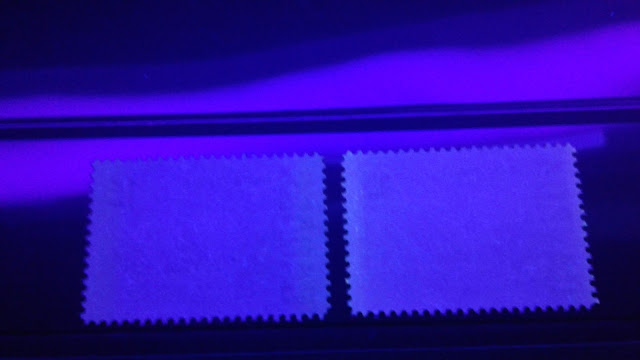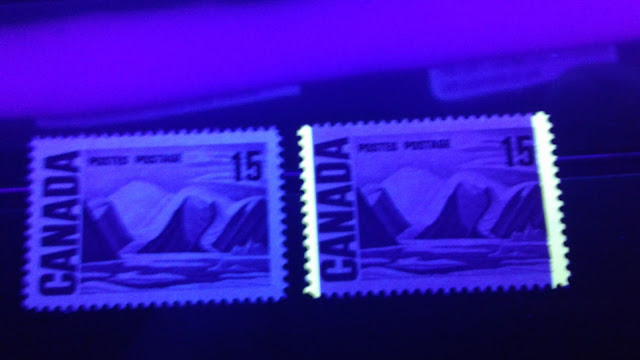Today's post will tackle the aspect of this issue that has probably received the most attention from specialists of this issue, and is definitely the most fun, but also the most confusing: the paper fluorescence. The study of paper fluorescence has been a "thing" since Irwin, Keane and Hughes, and Gronbeck-Jones published articles about this topic in the 1960's when the issue was current. However, it was, until relatively recently a fringe topic that was well outside the scope of even the Canada Specialized catalogue. I can well remember when I was a child in the early 1980's that the only paper varieties listed for this issue were plain paper and hibrite paper. However, since the late 1980's the topic of paper fluorescence has received more and more attention from mainstream philatelists, and consequently, the number of listings in the Unitrade specialized catalogue has grown considerably.
Despite this expansion in coverage, there is still, in my humble opinion, much inconsistency in the descriptions of papers, as well as some confusion when it comes to describing fluorescence levels. There are also other instances where very subtle, but real varieties are getting overlooked because the current nomenclature to describe the papers cannot accommodate the varieties, so that they get lumped in with other paper types.
The tricky part to today's post will be getting illustrations of the varieties that show the fluorescence well. Because I have to use my ultra-violet light to show the paper types, I cannot use my scanner, and have to rely instead on my digital camera. This does not have the best resolution, but I will try to take the best pictures that I can, and hopefully they will be of sufficient clarity to illustrate what I am talking about here.
Points of Confusion in Describing Fluorescence and Attributes
As my pictures will show, the nomenclature in Unitrade that has been used to describe fluorescence is confusing because quite often two very similar stamps will be described differently, while the same basic descriptor, such as "F" for fluorescent, LF for low fluorescent, or HB for hibrite, can look very different on different stamps. This is not a desirable state of affairs for someone who is trying to properly classify their stamps, and who do not have the benefit of a large reference collection against which to compare their stamps. In any event, it should not be necessary to have such a collection on hand. A good system of nomenclature should enable a complete novice to properly identify and classify their stamps using straightforward descriptions.
Why does this confusion arise?
The main reason is that there are several dimensions to paper fluorescence:
These stamps to my eyes are both low fluorescent overall, although Unitrade classifies the one on the right as medium fluorescent. The stamp on the left is dull bluish white while the one on the right is a clear bluish white.
The above picture shows four coil pairs for the 8c library coil. Three of these are general tagged: the left pair, and the two pairs on the right. All four of these pairs contain some fluorescent fibres, but in varying amounts and brightness:
Here is a close up shot of the last two papers:
Here you can see that on the left pair there is a light sprinkling of fluorescent fibres across the surface of the stamp, but there are large areas of the stamp that have no fibres, Whereas on the right pair, there is a fairly even distribution of the fibres, right across the surface of the stamp.
Here is a close-up of the first two pairs. As you can see on both, there are still quite a few fibres visible, but they are spread very, very far apart across the entire paper surface. This is what I call very sparse.
Here is another example of sparse on the left and low density on the right. The stamp on the left is the 10c Jack Pine with PVA gum. It is what Unitrade classifies as LF. In reality, the paper is LF-fl, BW, MF, S. The stamp on the right is classified in Unitrade as MF, because it is brighter than the stamp on the left, but in reality is not quite bright enough to be a true MF. Upon closer examination it is really low fluorescent white with a low density concentration of LF fibres, or LF-fl, white, LF, LD, by my naming convention.
Unitrade lists the 6c black CBN die with precancel and general tagging as being on either F, LF or MF paper, while the untagged precancel is listed as LF. The non-precancelled stamps with 4 mm general tagging are listed as being either NF, LF/fl or HF. Clearly, at first glance the first two stamps and the right stamp appear similar, which would suggest LF, even though Unitrade uses LF for two of them and LF/fl for one. The third stamp is clearly what Unitrade classifies as MF.
Here is the common, plate 3 PVA gum printing of the 15c that Unitrade classified as F paper. It clearly is no brighter than LF overall and is actually DF-fl, GW, LF, LD.
Despite this expansion in coverage, there is still, in my humble opinion, much inconsistency in the descriptions of papers, as well as some confusion when it comes to describing fluorescence levels. There are also other instances where very subtle, but real varieties are getting overlooked because the current nomenclature to describe the papers cannot accommodate the varieties, so that they get lumped in with other paper types.
The tricky part to today's post will be getting illustrations of the varieties that show the fluorescence well. Because I have to use my ultra-violet light to show the paper types, I cannot use my scanner, and have to rely instead on my digital camera. This does not have the best resolution, but I will try to take the best pictures that I can, and hopefully they will be of sufficient clarity to illustrate what I am talking about here.
Points of Confusion in Describing Fluorescence and Attributes
As my pictures will show, the nomenclature in Unitrade that has been used to describe fluorescence is confusing because quite often two very similar stamps will be described differently, while the same basic descriptor, such as "F" for fluorescent, LF for low fluorescent, or HB for hibrite, can look very different on different stamps. This is not a desirable state of affairs for someone who is trying to properly classify their stamps, and who do not have the benefit of a large reference collection against which to compare their stamps. In any event, it should not be necessary to have such a collection on hand. A good system of nomenclature should enable a complete novice to properly identify and classify their stamps using straightforward descriptions.
Why does this confusion arise?
The main reason is that there are several dimensions to paper fluorescence:
- The brightness of the paper under long wave ultraviolet (UV) light.
- The colour of the paper under UV.
- Whether of not the paper is of uniform, or compound fluorescence.
The problem with the Unitrade nomenclature that I see, is that papers are classified according to their overall appearance, and these three dimensions are all lumped together, so that where many papers would be described differently if all three dimensions were considered separately, they are all forced into the same general category. Let us consider what these dimensions actually are, and how they vary.
Brightness of the Paper
The brightness of the paper refers to the light that is reflected back when the stamps are viewed under UV. Keane and Hughes had a numeric scale to describe this that ran from 0 to 10. This is useful for those philatelists who can compare and contrast different papers, but I very highly doubt that a novice, or even two experts would agree, for instance on the difference between say, a 3 and a 4 on the scale, or an 8 and a 9. So the numeric scale suffers from a lack of objectivity.
Most philatelists use qualitative terminology to describe these different levels of brightness. The terms most commonly used are:
- Dead paper, which is at the lowest end of the scale.
- Non-fluorescent (NF) paper.
- Plain or dull paper (DF).
- Low-fluorescent (LF) paper.
- Medium-fluorescent (MF) paper.
- High fluorescent (HF) paper.
- Hibrite paper (HB), at the highest end of the scale.
The difficulty with these terms is how to apply them to classify a particular stamp. The above three pictures taken with my camera show the various levels of brightness and I will attempt to explain how one can get a sense for which fluorescence levels are which. I highly doubt that a complete novice will be able to easily distinguish between dead and NF or between MF and HF, or HF and HB. However, they should not have too much trouble identifying DF versus NF or dead, LF versus DF, and HB. With experience, you will begin to develop a kind of sixth sense that will allow you to tell when paper is LF, MF or HF, as well as the difference between NF and dead, or the difference between HF and HB.
I prefer to start by considering what we are actually looking at when we view stamps in a darkened room under the UV light. The lamp itself emits a light purple coloured light, and in a darkened room, it is the only light source. So it may make sense to start by comparing how bright the paper appears to how bright it would normally appear in normal, incandescent, or daylight. Plain or dull paper, should, at its essence, be about as bright as paper would normally look in a room under low light, whereas fluorescent paper should always look brighter than this. Non-fluorescent and dead paper should look much darker than paper would appear under normal lighting conditions. Hibrite is reserved for the absolute brightest possible paper - it is so bright as to be a very bright white. So this explanation should help you sort your stamps into four groups:
1. Dead or NF.
2. Plain.
3. Low, or medium fluorescent,
4. High fluorescent or hibrite.
Once you have these four groups identified, you can sort them more finely to identify the finer differences.
The top picture shows dull fluorescence on the left, and high fluorescent on the right, with low and medium fluorescent in the middle. In the second picture, the two stamps on the left are low fluorescent overall, the middle stamp is medium fluorescent, while the stamp on the right is dull fluorescent. In the third picture, the stamp on the left is non-fluorescent, the middle stamp is dead and the right stamp is hibrite.
Colour of the Paper
In addition to the brightness of the paper, there is also the colour. Some papers will appear violet, or light violet under the UV lamp. Others will appear greyish white, or greyish, while still others appear bluish white. Unitrade completely ignores this aspect of the paper, and there are many instances where there are several different papers, all of which are dull fluorescent, but which appear a slightly different colour.
The following pictures show some examples of these differences:
These 6c orange precancelled stamps are both on dull fluorescent paper, with the stamp on the left being greyish-white and the right stamp is greyish. Most philatelists would probably consider these to be the same paper, but to my eyes they are different.
These stamps to my eyes are both low fluorescent overall, although Unitrade classifies the one on the right as medium fluorescent. The stamp on the left is dull bluish white while the one on the right is a clear bluish white.
The stamp on the left is on dull fluorescent paper, and is a pure white, while the stamp on the right is a deep violet - almost the same colour as the light itself. The stamp on the right is on dead paper. Interestingly, there is no listing currently in Unitrade for a 4c precancelled stamp on dead paper, which goes to show that while the Unitrade listings are extensive, they are by no means complete.
Uniform Versus Compound Fluorescence and Naming Convention
This dimension of fluorescence is the most complicated of all. Uniform fluorescence is where the fluorescent reaction of the paper is of uniform colour and brightness across the entire stamp. The stamps in both the first and the third pictures above are uniform fluorescence, being either dull fluorescent or dead. Hibrite is generally a uniform fluorescence as well, as the reaction is the same across the surface of the entire stamp.
Compound fluorescence on the other hand, is where the paper, in addition to having an overall level of fluorescence, contains a number of fibres embedded in the paper that fluoresce either a different colour, a different brightness level, or both. These first began to appear in papers starting in about 1962. What is confusing is that Unitrade has been completely inconsistent in their naming of these papers, while also being inaccurate in their descriptions. Usually, the overall fluorescence level of these papers would read as low fluorescent, but that would only be because dull fluorescent paper contained a sparse number of fibres that would glow either low, medium or high fluorescent, and it is the presence of these fibres in varying concentrations that gives the overall fluorescent effect.
The picture below shows an example of this type of paper:
This picture shows the fluorescent fibres that are present in both papers. Both of these stamps are the 6c black transportation, printed from the CBN die. The stamp on the left is what Unitrade classifies as LF, while the stamp on the right is what Unitrade classifies as MF. The reality though is a bit more complicated. The stamp on the left does indeed read as a low fluorescent greyish overall, but there are MF fibres in the paper as well. There are a fair number of them, but they do not stand out much because they are only one level brighter than the overall paper. The stamp on the right has a basic fluorescence of MF, but also contains a lot of HF fibres, that stand out very clearly in this picture.
Unitrade has interchangeably used several names, abbreviations and terms to describe stamps that are essentially the same fluorescence:
- SF, which stands for speckled fluorescent has been used to describe paper like the above.
- LF-fl has been used to stand for low fluorescent flecked, which is how the above paper has often been described.
- F, which stands for fluorescent has also been used to describe the above paper.
So if you find yourself feeling confused when you read Unitrade's listings, it is not without good reason.
My way of naming this type of paper is as follows, with an example:
DF-fl, Gr, MF, LD for the left stamp and LF-fl, white, HF, S for the right stamp.
What does all this mean?
On the left stamp:
- DF-fl stands for dull fluorescent flecked, for the fibres.
- Gr. stands for greyish, which is the colour of the paper under UV.
- MF refers to the fluorescence level of the fibres embedded in the paper,
- LD stands for low density, which means that the fibres cover the entire surface of the stamp, lightly, such that there is a lot of space between the fibres.
On the right stamp:
- LF-fl stands for low fluorescent, flecked, to describe the overall fluorescence, and the fact that there are brighter fibres embedded in the paper.
- white, describes the colour of the paper under UV.
- HF refers to the fluorescence level of the fibres embedded in the paper.
- S stands for sparse, which means that there is a light sprinkling of these fibres across the surface of the stamp, but the fibres are not at all dense, and there may be areas of the stamp where there are no fibres at all.
So within this dimension, that of compound fluorescence, there are two sub-dimensions:
- The brightness of the fibres.
- The concentration of the fibres.
Unitrade, once again ignores these distinctions, especially the concentration. I would submit that significant differences in the concentrations of these fibres suggest a different papermaking process, and at very least a different composition to the pulp. In my study of this, and other issues, I use the following naming convention to describe the density of the fluorescent fibres in the paper:
- 1 or 2 - No fibres at all visible, except literally just one of two lone fibres.
- VVS - very, very sparse - fewer than 10 fibres visible.
- VS - very sparse a very light sprinkling with no fibres at all on 50-75% of the surface area of the paper.
- S - sparse - a light sprinkling of individually visible fibres visible on 50-75% of the stamp surface. Large gaps are seen between individual fibres.
- LD - low density - a uniform coverage of individually visible fibres across 100% of the stamp surface.
- MD - medium density - a uniform coverage of fibres that while individually visible, are heavily concentrated, and often appear to merge together.
- HD - high density - almost looks as though it is uniform fluorescence, but on closer examination it is apparent that there is actually an extremely dense concentration of fluorescent fibres that are so close together, you often need a loupe to see them.
I do not have examples of all seven of these types, as not all of them exist on this issue. Some of these will only be found on later issues of the 1970's. But let me illustrate a few examples now:
The above picture shows four coil pairs for the 8c library coil. Three of these are general tagged: the left pair, and the two pairs on the right. All four of these pairs contain some fluorescent fibres, but in varying amounts and brightness:
- The first pair has a very sparse concentration of low fluorescent fibres. The overall paper is a dull fluorescent greyish, so that Unitrade would classify this as LF/fl because of the fibres. My name for this, given the above naming convention would be DF-fl, Gr., LF, VS.
- The second pair also has a very sparse concentration of low fluorescent fibres. However, this paper is a dull fluorescent greyish white. Unitrade will likely classify this as "F" paper. My name for this is DF-fl, GW, LF, VS.
- The third pair has a sparse concentration of medium fluorescent fibres. The paper is low fluorescent, bluish white. Unitrade will likely classify this as MF. My name for this paper would be LF-fl, BW, MF, S.
- The fourth pair has a low density concentration of HF fibres. The paper is a medium fluorescent bluish white. Unitrade will likely classify this as HF, but my name for it is MF-fl, BW, HF, LD.
Here is a close up shot of the last two papers:
Here you can see that on the left pair there is a light sprinkling of fluorescent fibres across the surface of the stamp, but there are large areas of the stamp that have no fibres, Whereas on the right pair, there is a fairly even distribution of the fibres, right across the surface of the stamp.
Here is a close-up of the first two pairs. As you can see on both, there are still quite a few fibres visible, but they are spread very, very far apart across the entire paper surface. This is what I call very sparse.
Here is another example of sparse on the left and low density on the right. The stamp on the left is the 10c Jack Pine with PVA gum. It is what Unitrade classifies as LF. In reality, the paper is LF-fl, BW, MF, S. The stamp on the right is classified in Unitrade as MF, because it is brighter than the stamp on the left, but in reality is not quite bright enough to be a true MF. Upon closer examination it is really low fluorescent white with a low density concentration of LF fibres, or LF-fl, white, LF, LD, by my naming convention.
Here are two 15c Bylot Island stamps with PVA gum. The stamp on the left is Winnipeg tagged, and is classified in Unitrade as LF. The stamp on the right is general tagged and is also classified by Unitrade as LF. Once again though, they are quite different. The stamp on the left is actually DF-fl, BW, LF, S, while the stamp on the right is LF-fl, BW, LF, LD.
As all of the above examples are stamps with PVA gum, I wanted to show an example of stamps with dextrose gum. The stamp on the left would be classified in Unitrade as dull paper, even though there are a very small number of low fluorescent fibres visible. This stamp would actually be named DF-GW, LF, VS by my naming convention. The middle stamps is what unitrade classifies as the creamy paper LF. In actuality, the paper is indeed a low fluorescent bluish white, but there is also a sparse concentration of MF fibres visible in the paper as well, so that the true name according to my naming convention should be: LF-fl, BW, MF, S.
More Examples of Confusing Paper Classifications
Hibrite Papers
All the above stamps are listed in Unitrade as hibrite. As you can clearly see, they are not all the same brightness level. In my opinion, only the 6c black block and the 6c coil pair are truly hibrite. The 7c coil pair and the 20c are more of a high fluorescent brightness.
Dull and Low Fluorescent Papers
Unitrade lists the 6c black CBN die with precancel and general tagging as being on either F, LF or MF paper, while the untagged precancel is listed as LF. The non-precancelled stamps with 4 mm general tagging are listed as being either NF, LF/fl or HF. Clearly, at first glance the first two stamps and the right stamp appear similar, which would suggest LF, even though Unitrade uses LF for two of them and LF/fl for one. The third stamp is clearly what Unitrade classifies as MF.
However, if we take the stamp on the right in the first picture and now lay it on top of the second stamp, we can see that it is clearly DF compared to the second stamp. This is odd, given that the untagged precanceled stamp is only listed as being LF.
Here is the common, plate 3 PVA gum printing of the 15c that Unitrade classified as F paper. It clearly is no brighter than LF overall and is actually DF-fl, GW, LF, LD.
The stamp on the left is the same, common plate 3 printing while the one on the right is the general tagged version. Unitrade only lists the general tagged version as LF or DF and these two look almost identical. The general tagged version is a little greyer, but is the same in all other respects.
This concludes my general discussion of paper fluorescence on this issue, and will form the basis for my discussion of fluorescence on the individual values of the series.
Next week, I will look at the different types of gum used on this issue.






